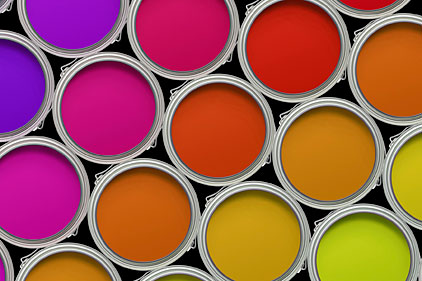Expand Product Reach by Printing Your Own Labels

In the coating manufacturing business, the ability to affordably produce short- to medium-run, full-color product labels can be a major competitive advantage. Manufacturers can use custom labels to test prototype products, enter the white label product sector or expand their product offering. But all of this requires the ability to affordably label products that are produced in smaller quantities.
In addition to the cost factor, expanding product reach also requires a way to produce and apply attractive labels. To effectively market paint and coating products, it’s absolutely crucial to package them attractively – professional-grade labels drive sales while a less-than-professional look can keep products on the shelf. However, many coating manufacturers find it a challenge to identify a solution that allows them to produce top-quality, full-color labels affordably. This article offers a look at various options.
Traditional Label Printing Methods
The default method for direct product labeling is to use flexographic (sometimes called “flexo”) printing, but there are downsides to this approach. Flexo printing is generally not cost effective unless the manufacturer produces a large number (10,000 or more) of identical labels. Color is also generally limited in flexo printing, and images such as logos or photos can be blurry.
Offset printing is another option, but like flexo, it’s typically not cost effective except for very large runs. Offset printing is limited to sheet-fed presses, which means manufacturers receive labels on flat sheets rather than in rolls. This is a serious drawback for many manufacturers, who prefer labels on rolls because they are easier to store and work with automated applicators.
Digital offset printing allows users to print variable information and accommodate shorter runs, but purchasing a press is cost-prohibitive for many companies – $100,000 and up. Securing digital offset printing services from a vendor is an option, but delivery times are typically several days to a week, and labels often require expensive lamination.
Color thermal transfer printing is another commonly used traditional label printing method. It has the advantage of accommodating shorter runs. However, the print resolution is typically very low. For this reason, it is used most often for shipping and box labels.
Newer Inkjet and Laser Label Printing Alternatives
Coating manufacturers who need alternatives that accommodate short- and medium-run label printing now have two additional options: color inkjet and laser label printing, which can both produce durable labels with full color and high resolution images. Inkjet and laser label printers can be an ideal solution.
Most consumers are familiar with inkjet printers from home and office use, and from that experience, many wonder if labels produced this way can stand up to the needs of a manufacturing application. However, professional-grade inkjet label printers use technology that produces robust, water-resistant labels on a variety of durable materials, including GHS-compliant substrates
Color laser printers are often used in office settings too. However, the use of a color laser printer designed for offices to produce labels poses some challenges. The printers are typically sheet-fed, so they can’t produce the rolls manufacturers prefer. Also, office-style laser printers typically require the use of regular paper, and when they handle adhesive materials, they usually need more maintenance.
However, there are printers on the market now that were specifically developed to print labels using inkjet and color laser technology. These printers were designed with label printing in mind and can handle a variety of labeling materials with ease. This feature is important for coatings manufacturers, whose products require labels that can stand up to exposure to water, chemicals and other elements.
A color laser printer designed to accommodate a straight paper path can handle self-adhesive labels and labels made of polyesters and other materials without encountering the adhesive bleeding, paper jams and label thickness issues other laser printers encounter. There are also color laser printers on the market specifically designed to handle short- and medium-run label production, and it’s possible to add roll-feeding controls, making this type of printer ideal for many manufacturers.
Label Finishing Options
Once labels are printed on a digital press, they typically require “finishing” from a second process. Steps usually include die-cutting, optional laminating, slitting and rewinding to finished rolls. Most finishing options require use of flexible or hard-tooled rotary or semi-rotary dies, which can make this option expensive and delay production, as the die is created and delivered.
Other options are available for manufacturers who need maximum flexibility and speed along with cost savings. One alternative is a system that uses pivoting knife blades to cut labels in a variety of sizes and shapes without use of a die. This option not only increases speed to market with up to four times faster production time, it’s generally much more affordable.
New Options Can Open New Opportunities
Coatings manufacturers can improve their competitive position with short- and medium-run label production capabilities, using labels to differentiate products, support campaigns and branch out into white label production. But first, they have to find an affordable solution that fits their needs, taking into account that the nature of the product will likely expose the labels to moisture and harsh chemicals and using labeling material that can handle that environment.
In a highly competitive market, it is also important for manufacturers to identify a printing option that is affordable to purchase and maintain while also providing the flexibility they need to handle short- and medium-runs quickly. Specially designed inkjet and color laser options can be an ideal solution, and a finishing system that doesn’t use dies can speed time to market.
Thanks to advances in printer technology, manufacturers have a number of options today. It’s possible to purchase a printing system that delivers the high-quality images that can set a product apart on the shelf without going over budget. While considering options, manufacturers should evaluate printers based on the price they can afford, the flexibility they need and the features they require. By choosing the right printing and finishing solution, coatings manufacturers can better compete.
Looking for a reprint of this article?
From high-res PDFs to custom plaques, order your copy today!






